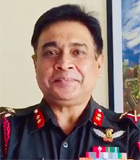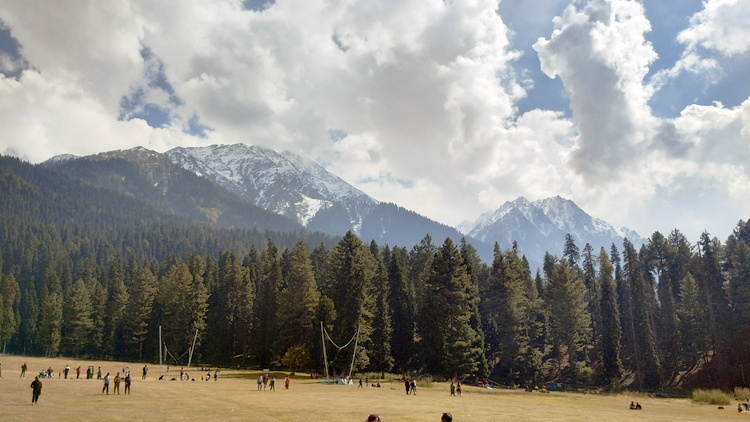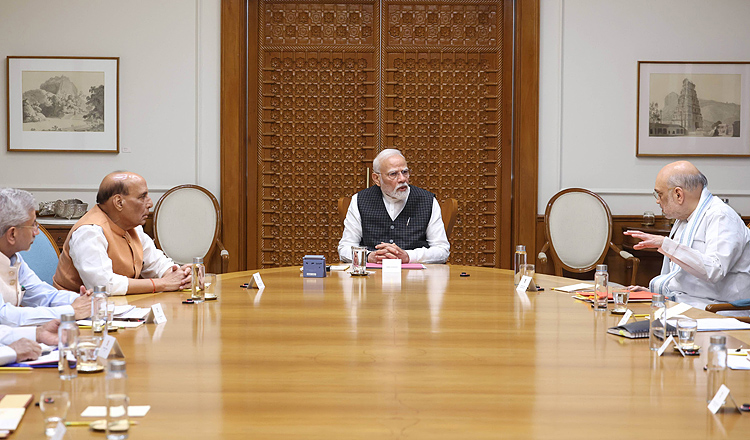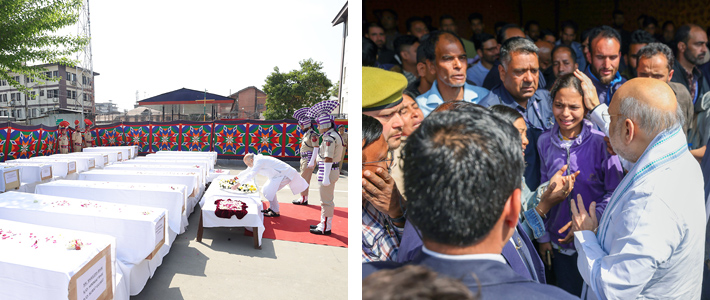INDIAN ARMED FORCES CHIEFS ON OUR RELENTLESS AND FOCUSED PUBLISHING EFFORTS

The insightful articles, inspiring narrations and analytical perspectives presented by the Editorial Team, establish an alluring connect with the reader. My compliments and best wishes to SP Guide Publications.

"Over the past 60 years, the growth of SP Guide Publications has mirrored the rising stature of Indian Navy. Its well-researched and informative magazines on Defence and Aerospace sector have served to shape an educated opinion of our military personnel, policy makers and the public alike. I wish SP's Publication team continued success, fair winds and following seas in all future endeavour!"

Since, its inception in 1964, SP Guide Publications has consistently demonstrated commitment to high-quality journalism in the aerospace and defence sectors, earning a well-deserved reputation as Asia's largest media house in this domain. I wish SP Guide Publications continued success in its pursuit of excellence.
- Operation Sindoor: Resolute yet Restrained
- Advanced MRSAM for India for a greater firepower
- Japan and India set forth a defence cooperation consultancy framework, talks on tank and jet engines
- Uri, Pulwama and now Pahalgam
- Terrorist Attack in Pahalgam in Kashmir: Unfolding a long surgical war against PAK
Uri, Pulwama and now Pahalgam
The Pahalgam attack on civilians, the deadliest of its kind since the September 2008 Mumbai attacks, specifically targeted male Hindus
 |
The Author is former Chief of Staff of a frontline Corps in the North East and a former helicopter pilot. He earlier headed the China & neighbourhood desk at the Defence Intelligence Agency. He retired in July 2020 and held the appointment of Addl DG Information Systems at Army HQ. |

The title list only goes back by about a decade. The Uri attack was carried out on September 18, 2016 by four Jaish-e-Mohammed terrorists from Pakistan against an Indian Army brigade headquarters near the town of Uri in J&K. 19 Indian soldiers were killed in the attack, and 30 others were injured. The 2019 Pulwama attack occurred on February 14, 2019, when a convoy of vehicles carrying CRPF personnel on the Jammu-Srinagar National Highway was attacked by a vehicle-borne suicide bomber at Lethapora in the Pulwama district. The attack killed 40 CRPF personnel. The responsibility for the attack was claimed by Jaish-e-Mohammed. This week, on April 22, 2025, a terrorist attack at Baisaran Valley near Pahalgam in the Anantnag district killed 26 tourists and injured more than 20 others. The attack, the deadliest of its kind since the September 2008 Mumbai attacks, specifically targeted male Hindu tourists. The Resistance Front (TRF), an offshoot of Lashkar-e-Taiba, has claimed responsibility for the attack.
Historical Precedents and the Systemic Persecution of Hindus
In reality, this is a pattern that goes back centuries, not a decade or decades. Hindu genocide, with millions violently and systematically eliminated over centuries and still counting, is the most ignored of all human tragedies. Denied by the historians and untold by its victimised survivors, the Hindu holocaust is one of the biggest "crimes against humanity" in world history. Hindus have time and again suffered religious persecution in the form of forceful conversions, massacres, demolition and desecration of temples, confiscation or destruction of property, incitement to hate, imprisonment, torture, murder, destruction of universities and schools and crimes against women and children.
The Hindu holocaust is one of the biggest 'crimes against humanity' in world history — denied by historians and untold by its victimised survivors
In recorded history, more than 70 million Hindus were massacred between 1000 and 1525 CE during the medieval Delhi Sultanate, for most of which period roughly the whole of the Indian Subcontinent was ruled from Delhi by powerful Sultans with Turkish and Mongol antecedents and exposure to Persianate political culture of Central Asia and Iran. Historian Ziya-ud-Din Barani's mid-14th century discussion of their reigns show not only that opponents resisting their conquests or regimes were brutally killed in large numbers during armed combat, but also that many of those captured alive were later massacred in cold blood. The women and children of soldiers from the other camp were not only imprisoned and enslaved, but also bodily harmed, often killed; women were also raped as punishment for alleged crimes of their male relatives. This should put into perspective why only Hindu males were singled out in Pahalgam, identification confirmed and then shot dead.

In the aftermath of the 1857 First War of Independence, an estimated 6,80,000 Hindus were massacred by the British. During the partition, some 2 million Hindus were butchered as they tried to flee or protect their women and children. Post independence, about 5,00,000 in 1950 riots and another estimated 3 million Hindus were mercilessly and violently killed in East Pakistan, now Bangladesh. Man made famines killed about 18 million Hindus between 1100 to 1700 CE under the Delhi Sultanate and Mughal rules while another 80 million perished between 1700 to 1950 during the British colonial rule. The chain of riots and massacres since independence will need voluminous chapters to describe and hence are being left out of further enumeration here. Desecration and destruction of temples, imposition of slavery and burning down of libraries, universities and centres of learning like Nalanda are another story altogether.
Strategic Shifts, Security Failures and India's Response
Since the bloody partition, Pakistan has harboured deep animosity towards India and this has found expression though three wars in 1947-48, 1965 and then 1971. Summarily defeated and humiliated, Pakistan chose to change tactics. General Zia-ul-Haq gave form to Bhutto's "thousand years war" with the 'bleeding India through a thousand cuts' doctrine using covert and low-intensity warfare with militancy and infiltration. This doctrine was first attempted during the Punjab insurgency in the eighties and in Kashmir since then. This bleeding continues.
General Zia-ul-Haq gave form to Bhutto's 'thousand years war' with the 'bleeding India through a thousand cuts' doctrine using covert and low-intensity warfare
Recounting history is necessary to put Pahalgam in perspective. It is not a one-off terrorist attack and definitely not the handiwork of a small terrorist organisation or some disgruntled and aggrieved locals. The genesis must be understood in its entirety in order to work on a response or strategy that has a somewhat lasting impact. The general public's expectation involves some kind of military action against terrorist bases and their backers in Pakistan. This is the 'commitment trap' that Prime Minister Narendra Modi faces after the Surgical Strikes in 2016 and the Balakot air strikes in 2019. But short term measures under public pressure and jingoism will not address the issue but rather play into hands of the perpetrators who have hoped to generate a reaction to this heinous act.

Pakistan remains the fountainhead of terrorism with dwindling sympathy even from some its own previous backers like UAE or Saudi Arabia. The US which leveraged and indulged Pakistan owing to its strategic location to wage its war against former Soviet Union in Afghanistan as well as to secure bases for clandestine operations against its challenger China is also re-calibrating under President Trump. The violent uprising in Baluchistan coupled with the Taliban turning the heat against Pakistan across the Durand line has left the Pakistani Army with very few options to regain its stature and primacy. Igniting Kashmir through cross border terrorism is a time tested option.
The abrogation of the Indus Water Treaty is the most significant step since this had survived through the wars in 1965 and 1971 as well as during the Kargil skirmish in 1991
India has announced a slew of diplomatic measures including holding the Indus Water Treaty (IWT) in abeyance, scaling down diplomatic missions and cancelling Pakistani visas apart from closing the Attari Wagah border. The abrogation of IWT is most significant step since this had survived through the wars in 1965 and 1971 as well during the Kargil skirmish in 1991. While some experts doubt the impact of annulling the IWT, rightly stating that India has little capacity to stop the flow of Indus water, many in the public are not aware of the measures taken in recent years to weaponise the IWT should the situation arise. Kishanganga HEP (tributary of Jhelum) is ready for diversion via a 23 kms tunnel since 2018. Tulbul navigation project (on Jhelum) was revived in 2016 and ready to regulate flow. Ratle HEP (on Chenab) was already revived in 2021. Work on two projects on River Ravi, at Shahpurkandi and Ujh, are in progress to stop flow of water into Pakistan. Executed deftly, they will have a cascading and debilitating impact on agriculture and power generation in Pakistan.
The Road Ahead: Escalation or Strategy?
The Pahalgam massacre has revealed many security gaps. Despite being located in terror prone Anantnag and timing with over 2000 tourist in Baisaran valley which has no road connectivity, there were no visible presence of police, paramilitary or army. An attack during a high profile visit has been a pattern. The US Vice President J.D. Vance was in the country and the Prime Minister of India in Saudi Arabia for extensive talks. The attack was timed to get maximum publicity and impact, disrupt the booming tourism and return to normalcy in the valley and advance Pakistan's long term agenda. An internal review is necessary.
India has the option of carrying out well-calibrated strikes against terror camps and its ecosystem including finances at a place and time of its choosing
Financially broken, facing the heat in Baluchistan and Khyber Pakhtunkhwa, Pakistan has its back to the wall. President Trump has effectively cut off financial flow to Pakistan and the CIA is under the careful watch of Director, National Intelligence Tulsi Gabbard who has been vocal about cutting off funding to varied terror outfits that maybe engaged in furthering US agenda in different parts of the world. UAE and Saudi are wary of radicalism disturbing their kingdoms and even China is sceptical of its CPEC projects after a series of deadly attacks on Chinese nationals engaged in executing the projects. China is also under pressure to normalise its relations with India since the tariff war erupted.
Prime Minister Modi has vowed to track and bring to justice the perpetrators of the crime. Pakistan has annulled the Shimla Agreement in retaliation which essentially means that the Line of Control (LOC) loses its sanctity and may give India multiple options. The country has to be prepared for the entire escalation ladder including a full-blown war. However, a war with a nuclear neighbour need not be the start point. India has the option of carrying out well calibrated strikes against terror camps and its ecosystem including finances at a place and time of its choosing. Needless to say, terrorism must be defeated by all means at the disposal of the state. The public have an important role to play in order that the strategy adopted by the state to demolish the terror ecosystem succeeds.





